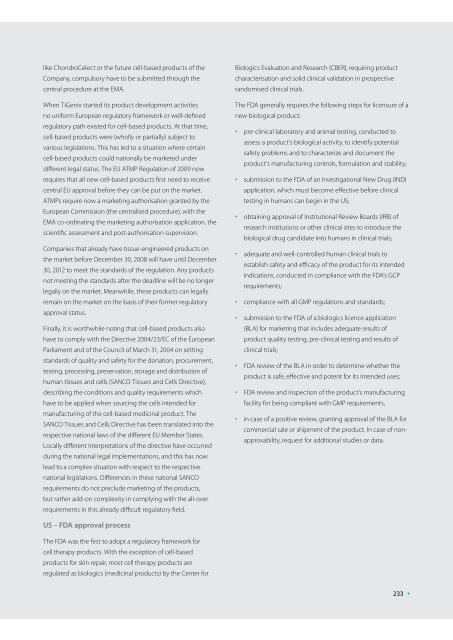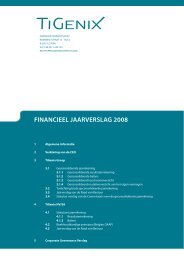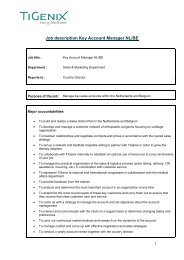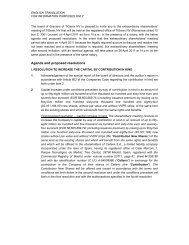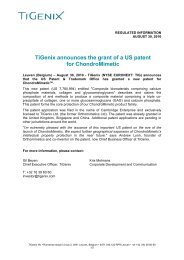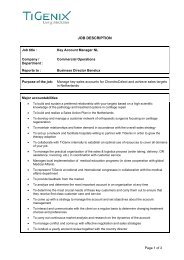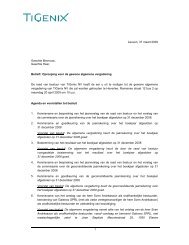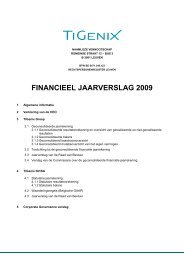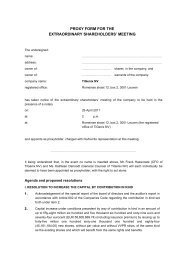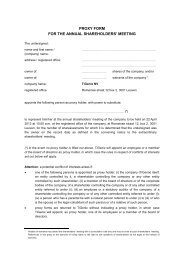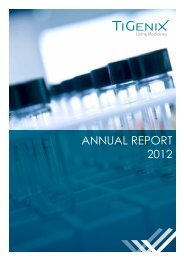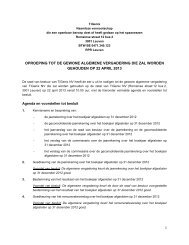ANNUAL FINANCIAL REPORT 2010 2010 - TiGenix
ANNUAL FINANCIAL REPORT 2010 2010 - TiGenix
ANNUAL FINANCIAL REPORT 2010 2010 - TiGenix
- No tags were found...
You also want an ePaper? Increase the reach of your titles
YUMPU automatically turns print PDFs into web optimized ePapers that Google loves.
like ChondroCelect or the future cell-based products of theCompany, compulsory have to be submitted through thecentral procedure at the EMA.When <strong>TiGenix</strong> started its product development activitiesno uniform European regulatory framework or well-definedregulatory path existed for cell-based products. At that time,cell-based products were (wholly or partially) subject tovarious legislations. This has led to a situation where certaincell-based products could nationally be marketed underdifferent legal status. The EU ATMP Regulation of 2009 nowrequires that all new cell-based products first need to receivecentral EU approval before they can be put on the market.ATMPs require now a marketing authorisation granted by theEuropean Commission (the centralised procedure), with theEMA co-ordinating the marketing authorisation application, thescientific assessment and post-authorisation supervision.Companies that already have tissue-engineered products onthe market before December 30, 2008 will have until December30, 2012 to meet the standards of the regulation. Any productsnot meeting the standards after the deadline will be no longerlegally on the market. Meanwhile, these products can legallyremain on the market on the basis of their former regulatoryapproval status.Finally, it is worthwhile noting that cell-based products alsohave to comply with the Directive 2004/23/EC of the EuropeanParliament and of the Council of March 31, 2004 on settingstandards of quality and safety for the donation, procurement,testing, processing, preservation, storage and distribution ofhuman tissues and cells (SANCO Tissues and Cells Directive),describing the conditions and quality requirements whichhave to be applied when sourcing the cells intended formanufacturing of the cell-based medicinal product. TheSANCO Tissues and Cells Directive has been translated into therespective national laws of the different EU Member States.Locally different interpretations of the directive have occurredduring the national legal implementations, and this has nowlead to a complex situation with respect to the respectivenational legislations. Differences in these national SANCOrequirements do not preclude marketing of the products,but rather add-on complexity in complying with the all-overrequirements in this already difficult regulatory field.Biologics Evaluation and Research (CBER), requiring productcharacterisation and solid clinical validation in prospectiverandomised clinical trials.The FDA generally requires the following steps for licensure of anew biological product:• pre-clinical laboratory and animal testing, conducted toassess a product’s biological activity, to identify potentialsafety problems and to characterize and document theproduct’s manufacturing controls, formulation and stability;• submission to the FDA of an Investigational New Drug (IND)application, which must become effective before clinicaltesting in humans can begin in the US;• obtaining approval of Institutional Review Boards (IRB) ofresearch institutions or other clinical sites to introduce thebiological drug candidate into humans in clinical trials;• adequate and well-controlled human clinical trials toestablish safety and efficacy of the product for its intendedindications, conducted in compliance with the FDA’s GCPrequirements;• compliance with all GMP regulations and standards;• submission to the FDA of a biologics licence application(BLA) for marketing that includes adequate results ofproduct quality testing, pre-clinical testing and results ofclinical trials;• FDA review of the BLA in order to determine whether theproduct is safe, effective and potent for its intended uses;• FDA review and inspection of the product’s manufacturingfacility for being compliant with GMP requirements,• in case of a positive review, granting approval of the BLA forcommercial sale or shipment of the product. In case of nonapprovability,request for additional studies or data.US – FDA approval processThe FDA was the first to adopt a regulatory framework forcell therapy products. With the exception of cell-basedproducts for skin repair, most cell therapy products areregulated as biologics (medicinal products) by the Center for233 •


